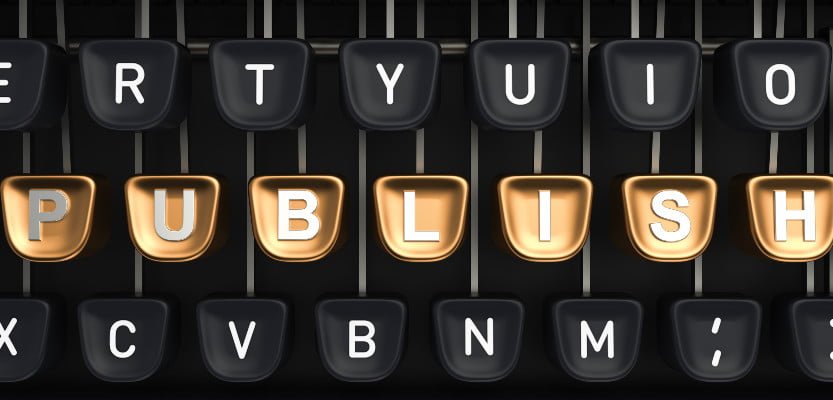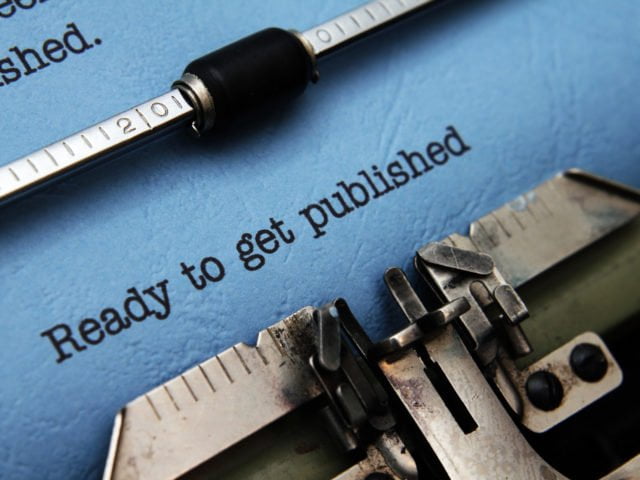To the uninitiated, the process of getting a book published can feel like an unfathomable mystery. It’s entirely forgivable to feel daunted by how to get your book published as a writer and how to get a book deal.
Finally holding your book in your hands can feel like a very distant dream for any new writer – let alone getting that all-important book contract!
So what do you do when you’ve finished your story? Should you even finish a full manuscript before you send it to literary agent, or is it better to send a partial manuscript with your query letter? Who do you send it to? Who will best be able to look after your work? How do you find a publisher? What are most agents looking for? Do you even need a literary agent? What about publishing it yourself?
And these questions are just the tip of the iceberg.
But don’t panic, because in this article I will be outlining everything an emerging writer needs to know before they get anywhere close to a publishing deal.
How To Get Published- The Three Main Paths
Even to the initiated, the publishing process can feel mysterious and confusing. I’ve been in the industry for over twenty years but that doesn’t mean I find it in any way straightforward. Although that’s also what makes it interesting and exciting.
There are many possible routes from manuscript to published book. The following guide will provide you both with the map you need to start finding your way through those woods – and some good reasons to start putting one foot in front of another.
The first thing to know about getting a book published is that there are three main paths: traditional publishing, self-publishing and hybrid publishing. I’ll describe each of these in detail as this article goes on, but briefly, for now:
Traditional publishing is the route where you sign a contract with a commercial publisher who will be responsible for getting your book made and then out in the world, in the shops and into readers’ hands. This should also include editing, marketing and distribution. More on that later.
Self-publishing is, as the name suggests, the route where you take on the responsibility of producing, marketing and selling your own work.
Hybrid publishing is, as the name also suggests, a kind of blend of the two, where an author might pay for some of the services that traditional publishers supply and do the rest themselves.
There are also numerous other options including crowdsourcing, putting work on fan forums, online platforms like Wattpad, and approaching various specialist forms of micropress. But I’ll get to all that as we get deeper into things.
For now, let’s focus on traditional publishing because I know it’s the aspect of getting published most authors at the early stage of writing are curious to hear about, and what most have in mind as their desired end point.

Traditional Publishing
Traditional publishing is what a lot of people think of when they consider writing a book and getting it published. It’s so traditional that you can trace its lineage at least back to Guttenberg.
The business of printing and selling books is still recognisable from the 15th century. ‘Traditional’ is a useful label to use to conceptually separate this kind of publishing from self-publishing and hybrid publishing. Not that any readers consider it when browning through books in a store.
Traditional publishing is what the majority of people think of when they think about publishing at all. It’s the business of seeing an author’s manuscript through from completion to the moment it is sold in the shops – and of trying to make a profit from it.
The UK and US publishing market is dominated by the ‘Big Four’ (Penguin Random House, Hachette Livre, Harper Collins and Pan Macmillan) who are responsible for numerous imprints publishing all manner of literary fiction, genre fiction, and non-fiction and have multi-million pound annual turnovers. There are also dozens more medium sized publishers like Bloomsbury, Oxford University Press, WW Norton, Faber & Faber and Canongate who also have annual turnovers in the millions. And then there are hundreds of smaller independent presses and micro-presses catering to all kinds of tastes and interests.
How To Get Your Book Published Traditionally
Finding the right publisher for you can be tricky, so here are some key things to consider.
Importantly, this form of publishing does not cost the writer anything. Instead, the publishing house pays the author. Generally a traditional publisher will give writers an advance against royalties (anything from £100 to £100,000 and more) and then a percentage of the sales (generally something in the region of 10-25%) once that advance has earned out (ie the book has sold enough copies to make back that publisher’s initial investment).
It’s important to note that the advance is rarely a reflection of the quality of the book that has been acquired, but can be determined by how much interest it has had (ie if more than one publisher wants it then it may go to auction), or it may reflect the writer’s past successes or ability to sell books (ie a celebrity). This is why a literary agent is important, as they will do their best to negotiate the very best deal for you.
The publishing house also foots the bill for all the other vital parts of the book production process such as cover design, editing, print, distribution, marketing, and promotion.
Already you can see the benefits of having a literary agent and not having to pay for all the important and expensive parts required to get your book published – but there are also more advantages for writers:
Having A Literary Agent
Agents are like brokers for the publishing industry. You’re a lot more likely to get a great book deal (and have your announcement appear in trade press, such as the much-coveted Publishers Weekly) if you have an experienced and supportive agent. More on how to get one further down the article…
Agents are experts at getting books in front of publishers, at knowing what publishers will want to see, and they often already have a great relationship with editors – knowing which publisher and editor is most likely to sign your novel.
Most agents will also work with you on your manuscript to help get it into shape before submission, looking at sample chapters and suggesting edits. There are many different agencies with a vast range of specialities, so not only is it vital you approach the right ones but that you form a strong working relationship with them.
Successful authors can work alongside these agents for years and years, and together they build great careers for one another. But remember you only need an agent for a traditional publication, not when you go out and do it yourself!

Editing
Good publishing houses have skilled and experienced editors who are experts at helping writers make their books as clear and complete as they can be, this applies to both fiction and nonfiction books. Editors should help with line edits, structural edits and everything in between.
For instance, a great editor will help fiction writers bring their characters to life, avoid plot holes, keep a grip on pacing, and keep to the ideal word count. They will also help non-fiction writers martial and order their arguments, check their facts, and avoid mistakes.
Editors will have a good understanding of the readers you want to reach out to, as well as the nuts and bolts of the writing process. They will often be the best in the world at what they do and their help can be invaluable. Very few great books have become a success without the help of an equally great editor!
Professional Production And Printing
As well as working on editorial, publishers are responsible for copy-editing and proofreading manuscripts and also for getting them properly typeset. (Typesetting is the art of getting arranging words on the page so they look good, without strange gaps and more. It is a crucial, if generally invisible part of the process. Read more about it here.)
Traditional publishers design covers and write blurbs, as well as help find great quotes from top authors to help promote your work. They also oversee the printing of the books (normally via an offset printer, not digital print on demand) and the preparation of ebooks.
All these things are complicated technical processes involving considerable skill and knowledge. Without a traditional publisher, doing these jobs properly can cost a lot of money (and those who self publish soon learn the hard way that doing these things yourself can damage sales and careers).
Publishers also have the capacity to print very large numbers of books, if need be, leading us on to storage and distribution.
Effective Distribution
Once books are made, the next challenge is to store them and get them out into the shops when they are needed. Publishers have established networks to get this done and a dedicated sales team – not to mention the budget to promote them in the trade press.
They also have the necessary relationships with bookshops and other retail outlets to persuade them to stock the books. Remember, not all books that are published by a traditional publisher is guaranteed to end up in a bookshop – many factors are at play to ensure a book becomes a bestseller (even a book published by big names).
Publicity And Marketing
Talking of networks, the traditional publishing route also offers the best chance of getting your book seen by reviewers and journalists. They have the media contacts and the ability to achieve the necessary column inches.
If your book starts doing well they should also have the marketing muscle to make sure even more people hear about it via social media, digital advertising, PR, and trade press.
Kudos
Thankfully, some of the stigma has gone out of self publishing, especially as we are seeing more and more established and traditionally published authors become hybrid authors and releasing books both ways.
But that doesn’t mean that there isn’t still some prestige to getting a book published with established and well-regarded publishing houses.
If you spend a lot of time on places like Twitter, you may see a lot of criticism of publishers being gatekeepers and arbiters of taste. But take that with a pinch of salt. Partly because some of that social media bile comes from resentment, but also because being a gatekeeper is a publisher’s job and part of their strength.
For better or worse, publishers can bestow a seal of quality and approval (let’s be honest here, we all know a book published by Penguin and stocked in Waterstones is going to probably be better edited than a self-published book, with few reviews or press coverage, that you can only buy on Amazon).
The simple fact that a traditional publisher is prepared to put their time and money into a book is a demonstration to the world that someone other than the author believes in it – and not just in the ability of the writer, but the fact that book is more likely to appeal to a wider audience. After all, publishers aren’t signing books to be nice. It’s a business!
The fact that these big publishers are reputable professionals who know the industry and the market (or, at least, they ought to be!) and that they believe in your work should be a demonstration that the book has potential.
So it stands to reason that most authors start out wanting their book to be signed by one of the top four big publishing houses. But that doesn’t mean that route will find you money and fame.
In fact, a lot more money can be made (and a lot quicker) publishing your book yourself! It just involves a lot more skill, time, money and know how…

Self-Publishing
With this option of the publishing industry, authors take responsibility for the production and marketing of their books and all other parts of the process. Generally, this means they will publish ebooks of their works on platforms like Amazon and Smashwords. But they can also produce audiobooks of their work, print on demand paper copies, and even pay for their own print runs and book storage.
All this means that authors take responsibility not only for the words on the page, but how they are presented. It might be that they do all the work themselves, or they employ professional editors, copy-editors and proof-readers, cover designers and typesetters to help them present their intellectual property in the best possible condition.
There are also agencies who can help you convert your finished manuscript to ebook form – or you can use the in-house explanations and templates provided by platforms like Smashwords.
Once you’ve produced the necessary computer files, there aren’t normally too many more upfront costs when it comes to how to producing your own ebook. The platform you choose is generally supportive and easy to use, and they will help you get it out to readers while taking a percentage of each sale.
Print on demand suppliers like Lulu.com provide a similar system. They will offer you a cost per book based on your production specifications. The print on demand supplier will then take a percentage from the sale of each copy sold on their store, and pay some royalties to the author.
If you choose other print methods and print in bulk, you will generally be expected to pay those production costs yourself and will need to find a place to store all these books and sell them at either events or through distributors.
People choose to publish their books themselves for three main reasons:
- They’ve tried the traditional method, had no luck securing a literary agent or publisher, so decide to go out there on their own.
- They understand that their choice of genre or fiction is niche, and better suited to readers who look online for these kinds of books (because they aren’t commercial enough for book stores and big publishers to stock).
- The author is already established in their own right (ie big social media presence, or an expert in their field) so they know they will be able to make more money using their already-established captive audience and communication channels, and can sell books that way.This normally works best for a nonfiction book (ie you’re a famous gardener with a number of garden centres around the world where you can sell your book) or you’re a huge TikTok star and can promote your novel that way.
However you choose to produce your own book, or why, here is a list of reasons why it may be the right choice for you:
Ease Of Access
Perhaps the clearest advantage of self-publishing is that just about anyone can do it, and there are very few barriers to entry. If you want to write about cowboy mermaids in space, you can, there is absolutely no one stopping you!
Speed
You can also get your book out quickly.
When considering how to get your book published, ask yourself how important the timing is. A traditional publication may take three years from final draft to bookstore shelves (you need to find an agent, go on submission, secure a deal, then wait 12-18 months for your book to be released).
Most platforms offer a step by step process that helps you through production. This means that with just a small amount of know-how you can convert your manuscript into an ebook within hours. And it doesn’t take much longer for that book to pass the quality control checks on whichever platform you choose. After that you can start selling.
You Generally Get A Higher Percentage Of The Profits
Because there are far fewer people involved in the publication process and because there are fewer costs involved in getting your book out as an ebook, you can also generally expect to receive a higher percentage of the profits from each sale of your book than you would in the traditional publishing industry. (There are caveats to bear in mind here though. Self-published ebooks generally also have to have a lower cover price to attract buyers – so you’re only going to get a larger percentage of far less money. The books also tend to sell fewer copies.)
Control
Since you are in charge of the publishing process you also get to make all the decisions about when the book comes out, cover design and pricing. Plus you have full access to sales stats and get paid royalties monthly, not quarterly or yearly.
You Get To Unleash Your Creativity
Okay, this isn’t for everyone. Often book covers and their related artwork are best left to the professionals. But if you do have design skills, creating a self published novel gives you a great opportunity to make the most of your design, illustration and photography skills.

Hybrid Publishing
Also sometimes known as co-publishing, author-assisted publishing, or partnership publishing (and, more misleadingly, indie publishing) hybrid publishing is an umbrella term for a mix of traditional publishing and doing it yourself.
Generally, the publishing company offers professional publishing services when it comes to things like cover design and typesetting – and sometimes they will even take on distribution. But the author pays some of the upfront costs of getting the book made and into the world. Although don’t get these mixed up with vanity publishers, who we strongly recommend you stay clear of!
Many people opt for Hybrid as a ‘self-publishing but with help’ alternative. Here are a few advantages:
Ease Of Access
Because they are not taking a risk on your writing, hybrid publishers are often more likely to take your work on. The flip-side of this is that they will not always care about it as much – but if you have realistic goals and enter into the partnership with open eyes it can be a good way to get a decent quality version of your book out into the world.
More Control
Since you will be footing the bill that should also mean you get more say over the look and feel of the book, book cover design, when it’s released and how many copies are produced.
High Royalty Rates
Many hybrid publishers offer attractive royalty rates. But a word of caution here – because you are paying them upfront, they have less of an incentive to help promote your book as they have already earned from it.
Other Publishing Models
You can publish a book with a publisher in more than just three ways, as there are a huge variety of publishing companies out there. Other options include:
Micropresses
There are dozens of high quality small independent publishers in the UK and USA who represent books by all sorts of writers, releasing both top quality fiction and non-fiction. There are different definitions for what constitutes a small independent publisher or micropress, so let’s take a closer look.
Some say it’s a company that makes less than $50million a year (which is still pretty big!). One useful guide in the UK is the entry criteria for the excellent Republic Of Consciousness Prize for small presses which is an annual competition for publishers with fewer than 5 full-time employees.
In the USA (where everything tends to be bigger) the equivalent prize instead defines small presses as those which publish an average of 18 or fewer published titles per year. They generally operate more like a bigger publishing house and are likely to offer you a traditional publishing deal.
But all small presses accepting submissions are different. They all have their own personality and impact on the market, with different passions and beliefs. They cover everything from:
- Science fiction
- Children’s books
- Young adult books
- Hardcore literary fiction
- Short stories
- Non-fiction books
- Specialist books
- LGBTQ+ books
- Travel books
And much much more!
Smaller presses (including university presses) are often specialists, with distribution options to reflect that, and in most cases you don’t need to submit your work via an agent. But, the flip-side of that, is that your book may not reach as many people.
Crowdsourcing
This is an interesting alternative way to get your book published. As in hybrid publishing, the crowdsourcing publisher offsets some of the risk of publication by asking the creator to raise the funds necessary to produce and print a book.
But in this case, they are asking their target readers to help out!
In the UK the publishing company Unbound has published several successful and well-regarded books using its crowdfunding platform. And Kickstarter.com is now one of the biggest publishers of comics and graphic novels in the world because creators have had so much success on their platform.
Crowdfunding can work for creators because it connects them directly with their audience, the process of raising money for a work can also help to raise its profile and generate excitement. Plus, because many platforms have reward tiers that allow creators to offer extra incentives to their funders, it means creators and their fans get to work on a project together.

Digital First Publishing
Some big companies like Harper Collins have digital first imprints, a division that only produces ebooks and distributes them on relevant platforms. Many even accept un-agented authors.
Some genres (ie crime and thrillers) do incredibly well as ebooks, and if a book become an instant bestseller the publisher may choose to then print the book too.
Most digital contracts do not offer an advance and the publisher has a much lower investment in each book than under their traditional models. But this can also mean they sign on a multi-book deal, they can get it out sooner, and often pay higher royalty rates.
Amazon Publishing
Amazon offer a digital and print service that helps you quickly build your book and get it to market on the Amazon website. It’s one of the quickest ways to get your book ideas published and out into the world, and as they also offer a publishing service they have a ginormous captive audience to publicise it to.
Fan Fiction Forums
This is niche but it can often be a great way to build a dedicated readership.
If you’re a fan of something and love writing about it, there may well be people who love reading about it. There are numerous forums for the Star Wars universe, Harry Potter, the Twilight saga – and much more. Famously, the multi-million selling 50 Shades Of Grey started life as Twilight fan fiction and there have been other self published authors who have found mainstream success in this way by being snapped up by a traditional publisher.
And even if such breakthrough stories are rare, publishing on these forums can be a really good way to reach readers and practicing your craft.
Wattpad
Wattpad calls itself “The world’s most-loved social storytelling platform” and is so big it deserves a heading of its own.
With a community of millions of readers, writers publish their work directly via the site across a huge range of categories from adventure, LGBTQ+, romance, nonfiction books, books for young adults, historical and fan fiction. There are also – inevitably! – a whole range of erotic categories.
A number of Wattpad stories (mainly YA and romance) have even become successful TV series and films (ie Through My Window, The Kissing Booth, the After trilogy).

How Do You Get A Book Published?- General Tips
We’ve seen the main publishing options that are available, but many writers at the early stages of penning their novel will still have questions about how to write and publish a book.
So here are a few of the things that will help you on your journey:
Get Editing
The first step (no matter what publishing route you decide to take) is to get your manuscript in the best shape it can be. Finish it. Read it. Re-read it. Carefully check for elementary spelling and grammar mistakes as well as all the important matters of structure, plot holes, characterisation, flow, argumentation (we have a blog post on everything a writer needs on our site).
It often helps to set your manuscript aside for a while after you have finished writing. And also to print it out so that you can read it away from the screen in a new context. If you have trusted beta readers, bring them in too.
Consider Getting Professional Help
If you are uncertain about the quality of your work and how to develop it further, it can help to get a professional assessment.
Yes, friends may offer to help, but you really need an expert who is objective and honest. Professional writing mentors can answer all kinds of questions that may be nagging you.
- Is my query letter OK?
- How do I choose a book title?
- How long should my book be?
- Will anyone want my non fiction?
- Is my writing strong enough?
A mentor or professional editor will not only read your book proposal and manuscript, they will have had some of the same battles with finding the best publishing routes that you have and will guide and support you. Most writers find these services invaluable.
Take a look at the mentoring, editing and agent match services we offer at Jericho Writers.
Attend Writing Conferences
A good writers’ conference will give you the opportunity to meet industry professionals, to ask questions about what they are looking for and why, and listen to talks from established traditionally published writers, self-published writers, agents and publishers.
Being part of a writing community is important when it comes to meeting fellow writers who are also learning how to publish a book with a publisher. They are a great place to swap stories, give each other encouragement and to learn that you aren’t alone.
Why not take part in Jericho Writer’s York festival of writing, our Summer Writing Festival, or join our FREE writing community!
Scope Out The Market
Determine your genre, have a look at the kind of books that are being published in that genre and who is publishing them, and try and gauge what the public enjoy reading. This will help you decide the best route to market and how to get your book published the right way.
Approach Literary Agents
We’ve already discussed how it’s not possible to get a publishing deal with the big top four publishers without an agent. So how do you get one?
Most literary agents have what we call an MS Wish List – this is a clear outline of the kinds of books they are looking for and the kind of writing they enjoy reading. Do your research and draw up a list of those who are more likely to want to read your work.
It can be a bit of a mine field, but luckily you can find plenty of free resources on the Jericho Writers website:
A list of US literary agents along with tips on how to write your query letter
A list of UK agents along with tips on how to write your query letter
Discover our agent match service to help find your dream agent
Some more useful tips on how to approach agents

Put Together A Submission Pack
If you wish to become a published author of fiction, a submission pack is what literary agents ask to see once you have a finished manuscript and are seeking representation. In most cases, a submission pack consists of a query letter, a brief synopsis (and maybe a chapter by chapter summary) and a sample of your work. If you are writing non fiction it may be simply be a concept and some examples of writing plus credentials along with your query letter.
The most important tip about the submission pack is that you should carefully check on the website of each agent and publisher to see what they are asking for. Follow their submission guidelines carefully (some even request a certain font type and size).
Some may want to see a full manuscript. Some may want sample chapters. Some may want a chapter-by-chapter summary. Or some will have different requirements for different kinds of books. Make sure you tailor your submission accordingly. It’s not only good manners, it demonstrates that you know who you are applying to and care about what they want.
Here are more articles on the subject:
You can read a sample query letter here – along with some useful hints and tips
Here’s a guide to writing a novel synopsis
Here’s more information on how to present your manuscript
Build Your Author Platform
If you can raise your author profile through writing a blog post, being in the press, attracting social media followers and winning writing competitions, it can help to stand out to literary agents and publishers. Most writers like to start with at least a Twitter or Instagram account to appeal to their target audience.
Although building up your author profile before sending out a query letter isn’t vital to your success and won’t automatically lead to a book proposal (most literary agents, acquiring editors and readers simply want to read a great story), it can help grow a bigger audience for your writing, regardless of the path you wish to take to publication.
Now You Know How To Get Your Book Published!
Phew. You made it to the end – well done! I hope the information shared has helped you understand the best route to publication.
I also imagine that most of you reading this will be at the early stage of your writing career, whether fiction or non fiction. And the vast majority of you debut authors will now be wondering what the heck you’ve gotten yourselves into.
Well don’t worry, the writing community is a fun and supportive one, so at this stage just take your time and focus on writing a great story. Maybe bookmark this article and refer back to it at each stage of your journey.
Time To Get Going
The key things to consider, when choosing how to publish your book, is what you want out of it. Do you want to set your sights high and aim for the top dream of traditional publishing, see you books in Barnes and Noble and Waterstones, and even make the New York Times bestseller list? Do you want to write a book every two months, be in full control, and make lots of money? Or do you simply want to hold your book in your hands and have it read by your nearest and dearest?
Whatever you choose, this article demonstrates that there are many routes to publication, all of which have the potential to make you happy and proud. And at the end of the day, all that matters is that you finish your wonderful story, and that you share it with others.
So go on, get out there, and make it happen. Because we are right there beside you, cheering you on every word of the way!
Jericho Writers is a global membership group for writers, providing everything you need to get published. Keep up with our news, membership offers, and updates by signing up to our newsletter. For more writing articles, take a look at our blog page.










